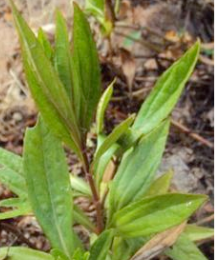Magic Reggie Botanicals
Ayapana/Caguena
Ayapana/Caguena
Couldn't load pickup availability
Eupatorium triplinerve
Main actions: Stomachic, antiulcerous, pectoral, vulnerary, anti-inflammatory,
hepatoprotective
Main uses: As a stomachic for digestive problems (nausea, vomiting,
stomachaches); for coughs, sore throat, colds, flu, strep throat and bronchitis;
for stomach ulcers, ulcerative colitis, IBS, and Crohn’s; for cuts, scrapes,
wounds and stop bleeding; for liver problems and conditions.
Cautions: Contains natural coumarins which may thin the blood.
The Shipibo-Conibo Indians of Peru take the leaf and stem of the plant internally for colic, stomach pain, swellings, and as a overall detoxifier. They prepare a paste of the leaves to use externally on wounds and hemorrhages to stop bleeding and speed healing. For internal hemorrhages, snake bite and vomiting they juice the leaves and drink it internally. In Peruvian herbal medicine the plant is believed to be sudorific (protes sweating), cicatrizant (closes wounds), astringent (dries secretions), stomachic (assists digestion), stimulant, febrifuge (reduces fever), antidiarrhetic, and anti-tumorous. The leaves are prepared in infusions, decoctions, baths and plasters to protect the liver, for inflammation of the urinary tract, and for tetanus. An infusion of the leaf and stem is used as a digestive stimulant and to ease nausea. Ayapana is thought to be antitumorous and used for cancerous tumors in both Peru and Argentina. An infusion of the entire plant is also used in Argentina to stimulate menstruation.
In Brazilian herbal medicine the leaf juice and an infusion of the leaves and stems are considered tonic, stimulant, astringent, antidysenteric and sudorific. An infusion of the leaves is mixed with honey and used for coughs and sore throats. A leaf infusion is also used for queasy stomachs, indigestion, diarrhea, fever, headaches, insomnia, nausea and vomiting, and stomach ulcers. The leaf juice is used externally as an astringent and emollient and is rich in vitamin C. The leaf juice is swished in the mouth for gingivitis and mouth ulcers. The leaf juice is also highly reputed against snakebite in the Brazilian Amazon and it's considered a good sedative when taken internally. It is also recommended externally for simple wounds and stubborn ulcers. Ayapana is also used for angina, gastric ulcers, cholera, eye and ear problems in Brazil.
In the Amazon region of the Guyanas (Surinam, Guyana, and French Guiana) ayapana is considered a febrifuge, alexiteric (anti-infective), sudorific, digestive, and laxative. A leaf infusion is employed for headaches, colds and flu, mouth sores and ulcers, and hypertension. The whole plant is decocted to relieve nausea and vomiting caused from malaria by the Palikur tribe of French Guiana and this same decoction is used in Surinam for chronic diarrhea.
Ayapana can be found outside the Amazon where it is also used in other herbal medicine systems. In India. ayapana is a popular herbal remedy and a leaf infusion is considered a cardiotonic, diaphoretic, emetic, hemostat, laxative, stimulant, and tonic. In Trinidad, the plant is used for chest colds, constipation, fevers, flu, pneumonia, and yellow fever. In Malaya it is considered sudorific and used for bronchitis and diarrhea.
Ayapana was first written about in the United States in the 1887 American Journal of Pharmacy which noted: "The leaves are recommended against indigestion, pectoral complaints and in cholera, and were used for similar purposes in Europe in the early part of the present century." Ayapana leaves are official in the French Pharmacopoeia and first recorded in 1801.
This information is gathered directly from:
https://rain-tree.com/ayapana.htm
Share

